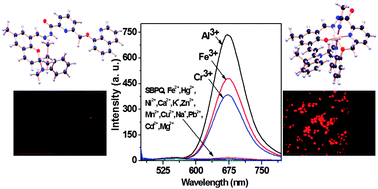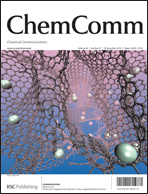A red fluorescence ‘off–on’ molecular switch for selective detection of Al3+, Fe3+ and Cr3+: experimental and theoretical studies along with living cell imaging†
Abstract
A spirobenzopyran-quinoline (SBPQ) based sensor was synthesized which selectively detects trivalent ions viz. Al3+, Fe3+ and Cr3+ through a fluorescence turn on signal in the red region (∼675 nm) with the detection limit in the order of 10−8 M. The potentiality of the probe was confirmed by employing it for fluorescence bio-imaging with Al3+ in three different types of live-cells.

- This article is part of the themed collection: ChemComm 60th Anniversary Historic Papers from India

 Please wait while we load your content...
Please wait while we load your content...